Numerical Investigation of Effect of Structural Parameters on the Performance of a Combustion-Driven Sparkjet Actuator
Abstract
:1. Introduction
2. Mathematical-Physical Model
2.1. Computational Model
2.2. Mesh Independency Test and Model Validation
3. Results and Discussion
3.1. Influence of Actuator Length
3.2. Influence of Actuator Orifice Diameter
4. Conclusions
- At a length and orifice diameter of 6.5 mm and 1.3 mm, respectively, the combustion-driven sparkjet actuator has a higher velocity and mass rate than the sparkjet actuator due to the heat release caused by combustion, while the saturation work frequency is almost the same.
- With the rise in volume in the actuator length range from 3.75 to 13 mm, the pressure, orifice velocity and mass rate of the combustion driver increase, whereas the saturation work frequency decreases. The reason for this is that the mixture mass rises as the combustion chamber size increases, which leads to a more heat release from combustion. Meanwhile, as the volume of combustion driver increases, the chemical reaction time increases, resulting in low work frequency.
- The outlet peak velocity, temperature, and pressure increase as the orifice diameter decreases from 2.8 to 1.3 mm. By contrast, the mass flow rate and saturation work frequency trend decrease. The reason for this is that the large orifice diameter reduces the blocking effect of the boundary layer thickness on the airflow at the outlet. Moreover, the mass of the hydrogen leakage increases with the increase in orifice diameter, leading to heat release and temperature decline. Therefore, the structural parameters of the actuator must be optimized reasonably according to different requirements.
Author Contributions
Funding
Data Availability Statement
Conflicts of Interest
References
- Zhang, X.; Li, H.X.; Huang, Y.; Wang, W.B. Wing Flow Separation Control Using Asymmetrical and Symmetrical Plasma Actuator. J. Aircr. 2016, 54, 301–309. [Google Scholar] [CrossRef]
- Kelley, C.L.; Corke, T.C.; Thomas, F.O.; Patel, M.; Cain, A.B. Design and Scaling of Plasma Streamwise Vortex Generators for Flow Sep-aration Control. AIAA J. 2016, 54, 3397–3408. [Google Scholar] [CrossRef]
- Popov, N.A. Kinetics of plasma-assisted combustion: Effect of non-equilibrium excitation on the ignition and oxidation of combustible mixtures. Plasma Sources Sci. Technol. 2016, 25, 043002. [Google Scholar] [CrossRef]
- Frischmuth, T.; Schneider, M.; Maurer, D.; Grille, T.; Schmid, U. Inductively-coupled plasma-enhanced chemical vapour deposition of hydrogenated amorphous silicon carbide thin films for MEMS. Sens. Actuators A Phys. 2016, 247, 647–655. [Google Scholar] [CrossRef]
- Wang, L.; Luo, Z.; Xia, Z.; Liu, B.; Deng, X. Review of actuators for high speed active flow control. Sci. China (Technol. Sci.) 2012, 55, 2225–2240. [Google Scholar] [CrossRef]
- Grossman, K.R.; Cybyk, B.Z.; VanWie, D.M. SparkJet Actuators for Flow Control; AIAA Paper. In Proceedings of the 41st Aerospace Sciences Meeting and Exhibit, Reno, Nevada, 6–9 January 2003. [Google Scholar]
- Hardy, P.; Barricau, P.; Belinger, A.; Caruana, D.; Cambronne, J.P.; Gleyzes, C. Plasma Synthetic Jet for Flow Control; AIAA Paper. In Proceedings of the 40th Fluid Dynamics Conference and Exhibit, Chicago, IL, USA, 28 June–1 July 2010. [Google Scholar]
- Jin, D.; Li, Y.H.; Jia, M.; Song, H.H.; Cui, W.; Sun, Q.; Li, F.Y. Experimental Characterization of the Plasma Synthetic Jet Actuator. Plasma Sci. Technol. 2013, 15, 1034–1040. [Google Scholar] [CrossRef] [Green Version]
- Zhang, Z.B.; Wu, Y.; Sun, Z.Z.; Song, H.M.; Jia, M.; Zong, H.H.; Li, Y.H. Experimental Research on Multichannel Discharge Cir-cuit and Multi-Electrode Plasma Synthetic Jet Actuator. J. Phys. D Appl. Phys. 2017, 50, 165205. [Google Scholar] [CrossRef] [Green Version]
- Tang, M.X.; Wu, Y.; Wang, H.Y.; Jin, D.; Guo, S.G.; Gan, T. Effects of Capacitance on a Plasma Synthetic Jet Actuator with a Conical Cavity. Sens. Actuators A Phys. 2018, 276, 284–295. [Google Scholar] [CrossRef]
- Liu, R.B.; Wang, M.M.; Hao, M.; Lin, Q.; Wang, X.G. Experimental research on air supplementing type plasma synthetic jet generator. Acta Aeronaut. Astronaut. Sin. 2016, 37, 1713–1721. [Google Scholar]
- Li, J.F.; Zhang, X.B. Active Flow Control for Surpersonic Aircraft: A Novel Hybird Synthetic Jet Actuator. Sens. Actuators A Phys. 2020, 302, 111770. [Google Scholar] [CrossRef]
- Wang, L.; Xia, Z.X.; Luo, Z.B.; Chen, J. Three-Electrode Plasma Synthetic Jet Actuator for High-Speed Flow Control. AIAA J. 2014, 52, 879–882. [Google Scholar] [CrossRef]
- Zhou, Y.; Xia, Z.X.; Luo, Z.B.; Wang, L. Effect of Three-Electrode Plasma Synthetic Jet Actuator on Shock Wave Control. Sci. China Technol. Sci. 2017, 60, 146–152. [Google Scholar] [CrossRef]
- Su, W.Y.; Chen, L.H.; Zhang, X.Y. Investigation of magnetohydrodynamic control on turbulent boundary layer separation induced by shock wave. J. Propuls. Technol. 2010, 31, 18–23. [Google Scholar]
- Zhou, Y.; Liu, B.; Wang, L.; Luo, Z.; Xia, Z. Numerical simulation of performance characteristics of two-electrode plasma synthetic jet and the influence of different actuator orifice shapes. Acta Aerodyn. Sin. 2015, 33, 799–805. [Google Scholar]
- Huang, H.X.; Tan, H.J.; Sun, S.; Zhang, Y.C.; Cheng, L. Transient Interaction Between Plasma Jet and Supersonic Compression Ramp Blow. Phys. Fluids 2018, 30, 041703. [Google Scholar] [CrossRef]
- Narayanaswamy, V.; Raja, L.L.; Clemens, N.T. Characterization of a High-frequency Pulsed-plasma Jet Actuator for Su-personic Flow Control. AIAA J. 2010, 48, 297–305. [Google Scholar] [CrossRef] [Green Version]
- Li, L.; Yuan, Z.; Xiang, Y.; Fan, A. Numerical investigation on mixing performance and diffusion combustion characteristics of H2 and air in planar micro-combustor. Int. J. Hydrogen Energy 2018, 43, 12491–12498. [Google Scholar] [CrossRef]
- Kim, W.H.; Park, T.S. Flame characteristics depending on recirculating flows in a non-premixed micro combustor with varying baffles. Appl. Therm. Eng. 2019, 148, 591–608. [Google Scholar] [CrossRef]
- Chen, H.; Liu, W.Q. Numerical Investigation of the Combustion in an Improved Micro combustion Chamber with Rib. J. Chem. 2019, 2019, 8354541. [Google Scholar] [CrossRef]
- Chen, H.; Liu, W.Q. Numerical study of effect of front cavity on hydrogen/air premixed combustion in a micro-combustion chamber. J. Cent. South Univ. 2019, 26, 2259–2271. [Google Scholar] [CrossRef]
- Hua, J.; Meng, W.; Kumar, K. Numerical simulation of the combustion of hydrogen–air mixture in micro-scaled chambers. Part I: Fundamental study. Chem. Eng. Sci. 2005, 60, 3497–3506. [Google Scholar] [CrossRef]
- Zuo, W.; Jiaqiang, E.; Hu, W.; Jin, Y.; Han, D. Numerical investigations on combustion characteristics of H2/air premixed combustion in a micro elliptical tube combustor. Energy 2017, 126, 1–12. [Google Scholar] [CrossRef]
- Crittenden, T.; Glezer, A.; Funk, R.; Parekh, D. Combustion-Driven Jet Actuators for Flow Control; AIAA Paper. In Proceedings of the 15th AIAA Computational Fluid Dynamics Conference, Anaheim, CA, USA, 11–14 June 2001. [Google Scholar]
- Crittenden, T.M.; Warta, B.J.; Glezer, A. Characterization of Combustion Powered Actuators for Flow Control. In Proceedings of the 3rd AIAA Flow Control Conference, San Francisco, CA, USA, 5–8 June 2006. [Google Scholar]
- Rajendar, A.; Crittenden, T.; Glezer, A. Effect of Inlet Flow Configuration on Combustion Powered Actuators; AIAA Paper. In Proceedings of the 48th AIAA Aerospace Sciences Meeting Including the New Horizons Forum and Aerospace Exposition, Orlando, FL, USA, 4–7 January 2010. [Google Scholar]
- Srinivasan, S.; Girgis, B.; Menon, S. Large-Eddy Simulation of a Combustion Powered Actuator; AIAA Paper. In Proceedings of the 44th AIAA/ASME/SAE/ASEE Joint Propulsion Conference & Exhibit, Hartford, CT, USA, 21–23 July 2008. [Google Scholar]
- Crittenden, T. Environmental Testing Of Combustion Powered Actuators for Flow Control; AIAA Paper. In Proceedings of the 37th AIAA Fluid Dynamics Conference and Exhibit, Miami, FL, USA, 25–28 June 2007. [Google Scholar]
- Jee, S.; Bowles, P.O.; Matalanis, C.G.; Min, B.Y.; Wake, B.E.; Crittenden, T.; Glezer, A. Computations of Combustion-Powered Actuation for Dynamic Stall Suppression. In Proceedings of the American Helicopter Society (AHS) Annual Forum, West Palm Beach, FL, USA, 15 July 2016. [Google Scholar]
- He, Z.; Yan, Y.; Zhao, T.; Feng, S.; Li, X.; Zhang, L. Heat Transfer Enhancement and Exergy Efficiency Improvement of a Micro Combustor with Internal Spiral Fins for Thermophotovoltaic Systems. Appl. Therm. Eng. 2021, 189, 116723. [Google Scholar] [CrossRef]
- Smooke, D.M.; Miller, J.A.; Kee, R.J. Determination of Adiabatic Flame Speeds by Boundary Value Methods. Combust. Sci. Technol. 1983, 34, 79–90. [Google Scholar] [CrossRef]
- Akhtar, S.; Kurnia, J.C.; Shamim, T. A three-dimensional computational model of H2–air premixed combustion in non-circular micro-channels for a thermo-photovoltaic (TPV) application. Appl. Energy 2015, 152, 47–57. [Google Scholar] [CrossRef]
- Wang, L.; Luo, Z.B.; Xia, Z.X.; Liu, B. Energy efficiency and performance characteristics of plasma synthetic jet. Acta Phys. Sin. 2013, 62, 125207. [Google Scholar] [CrossRef]
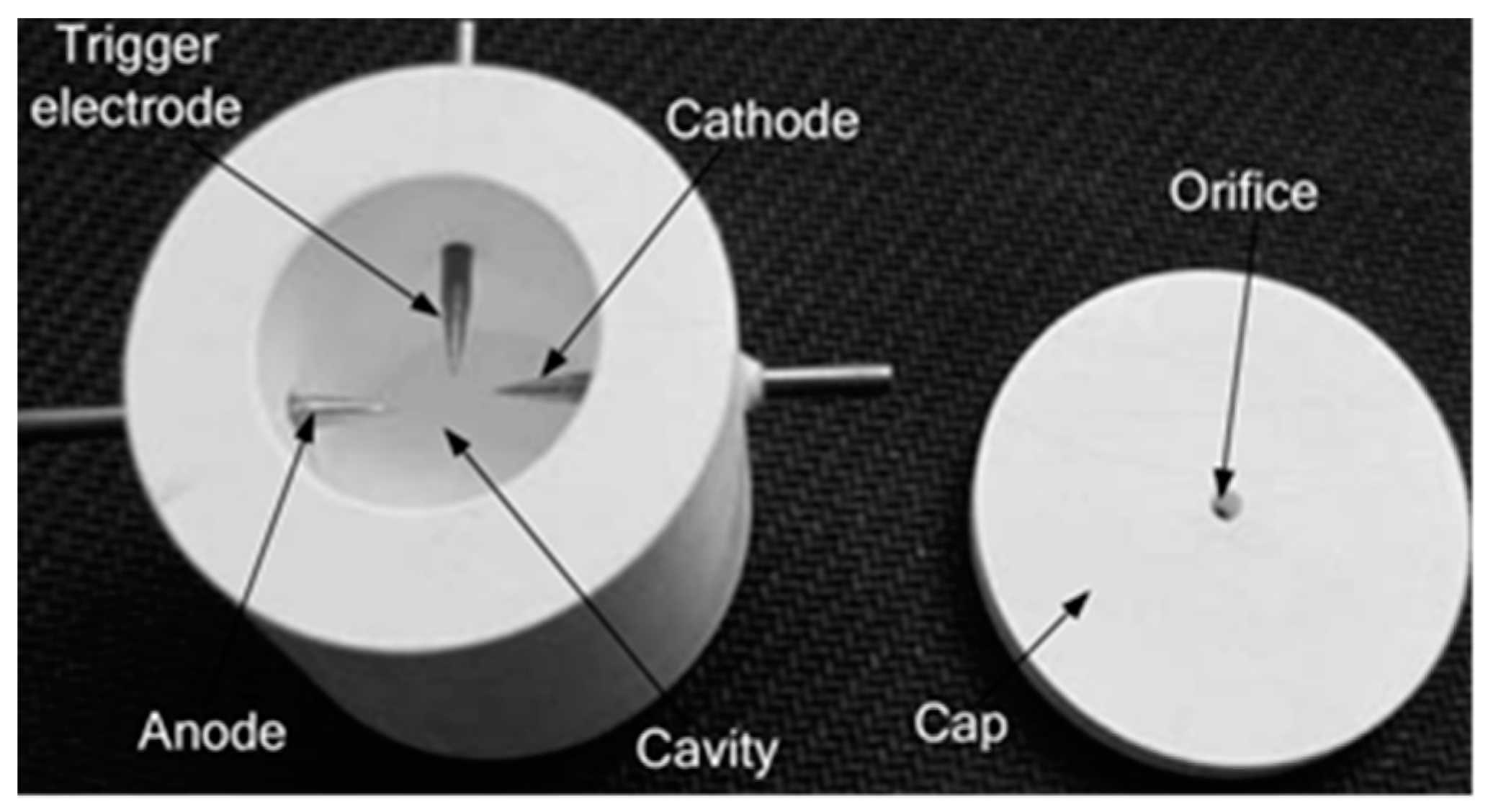
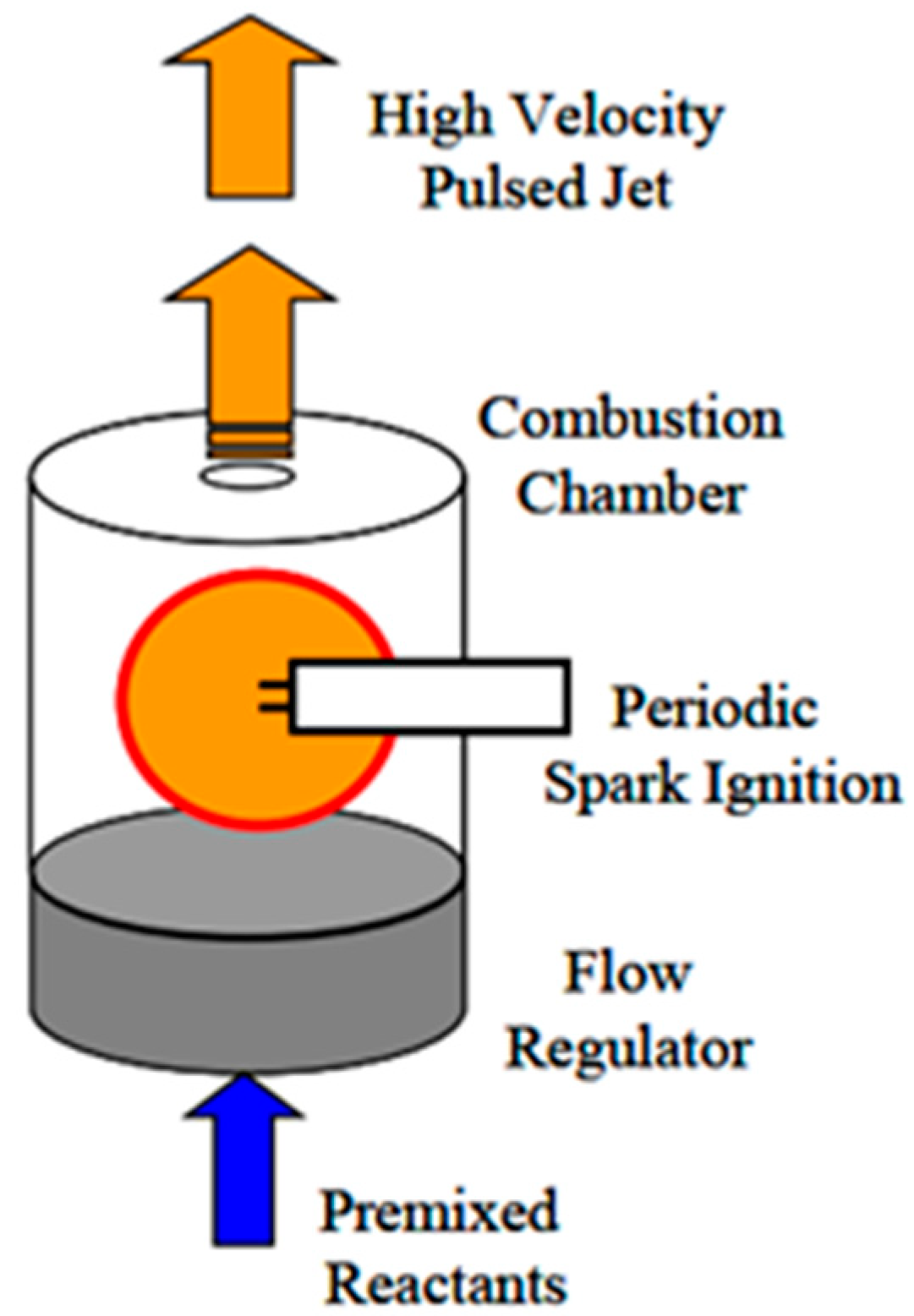

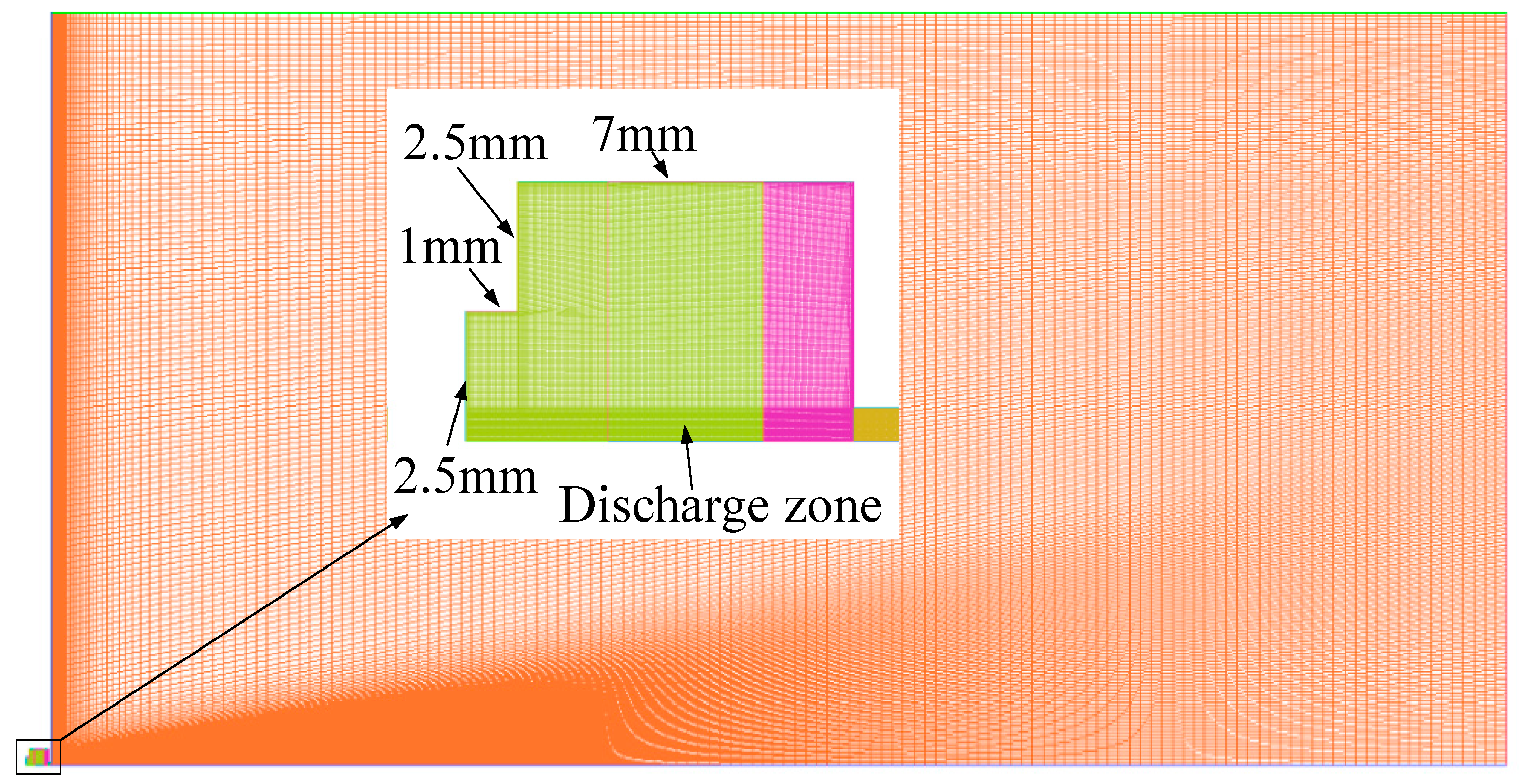

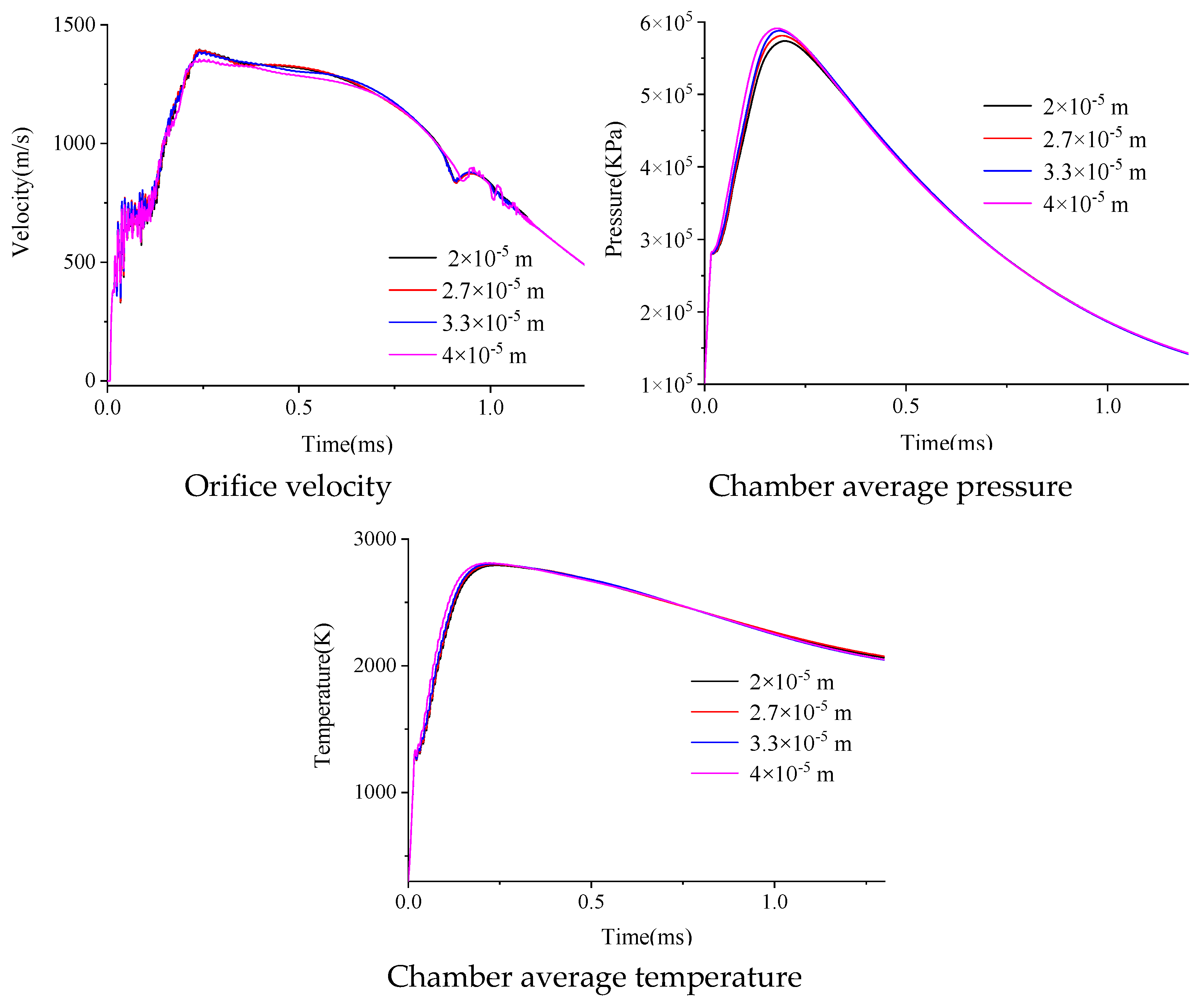
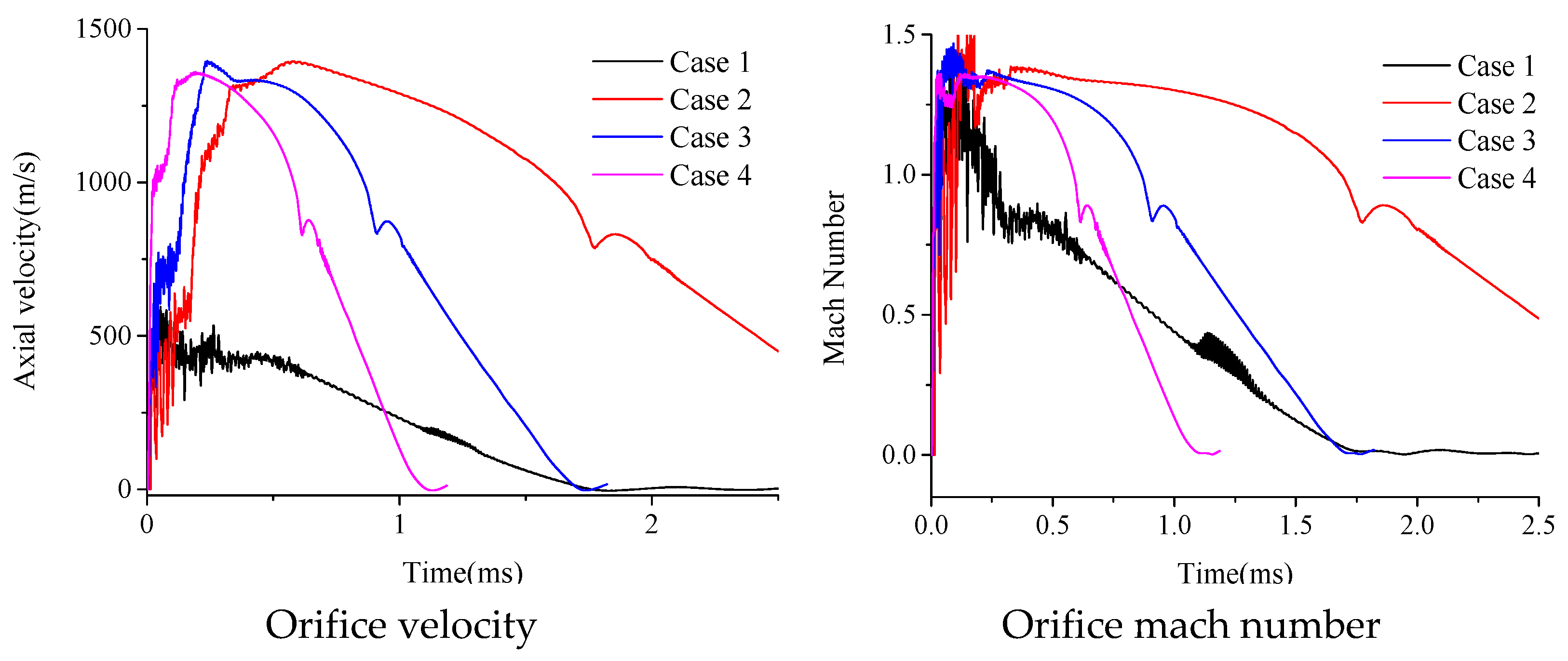
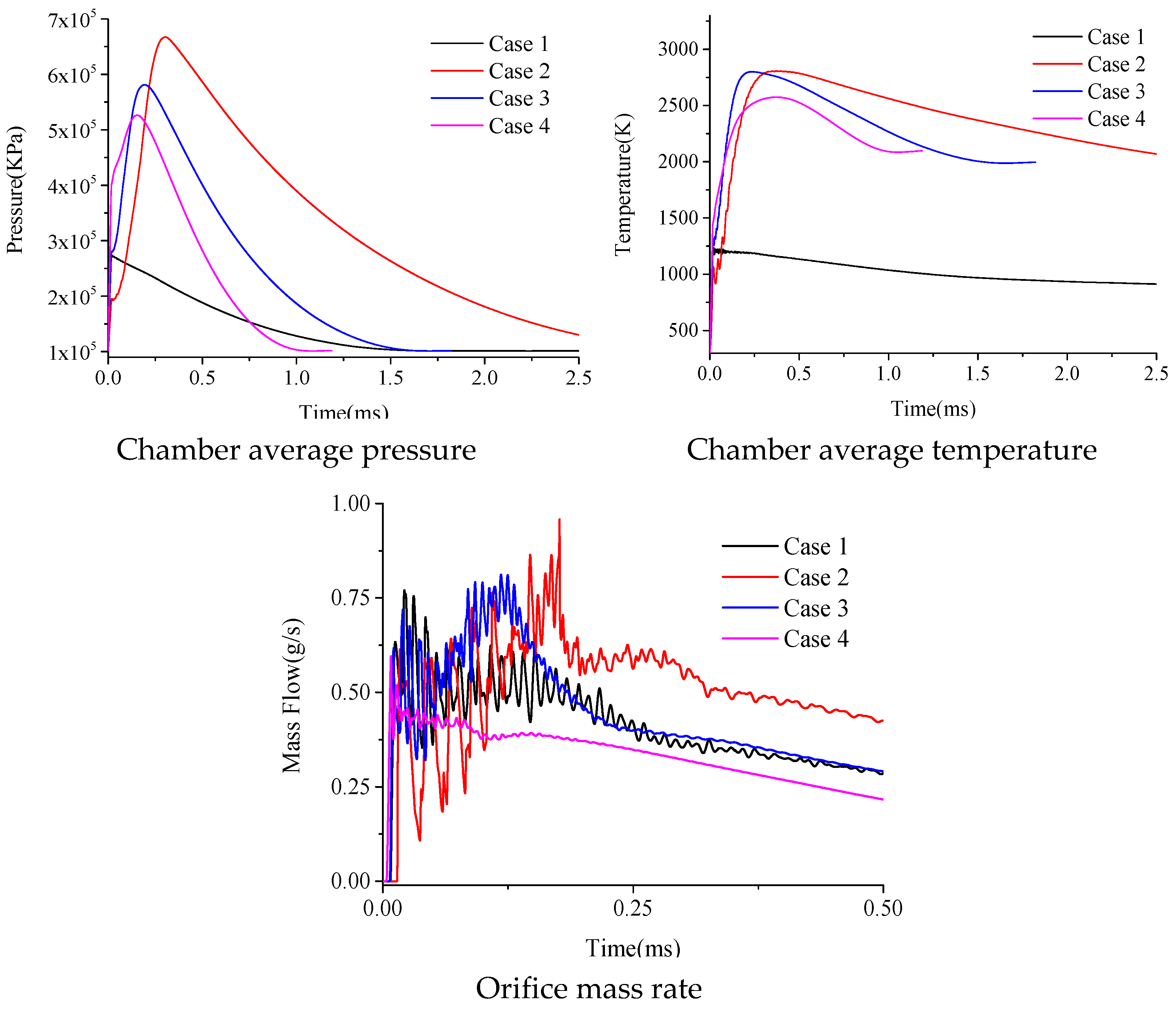

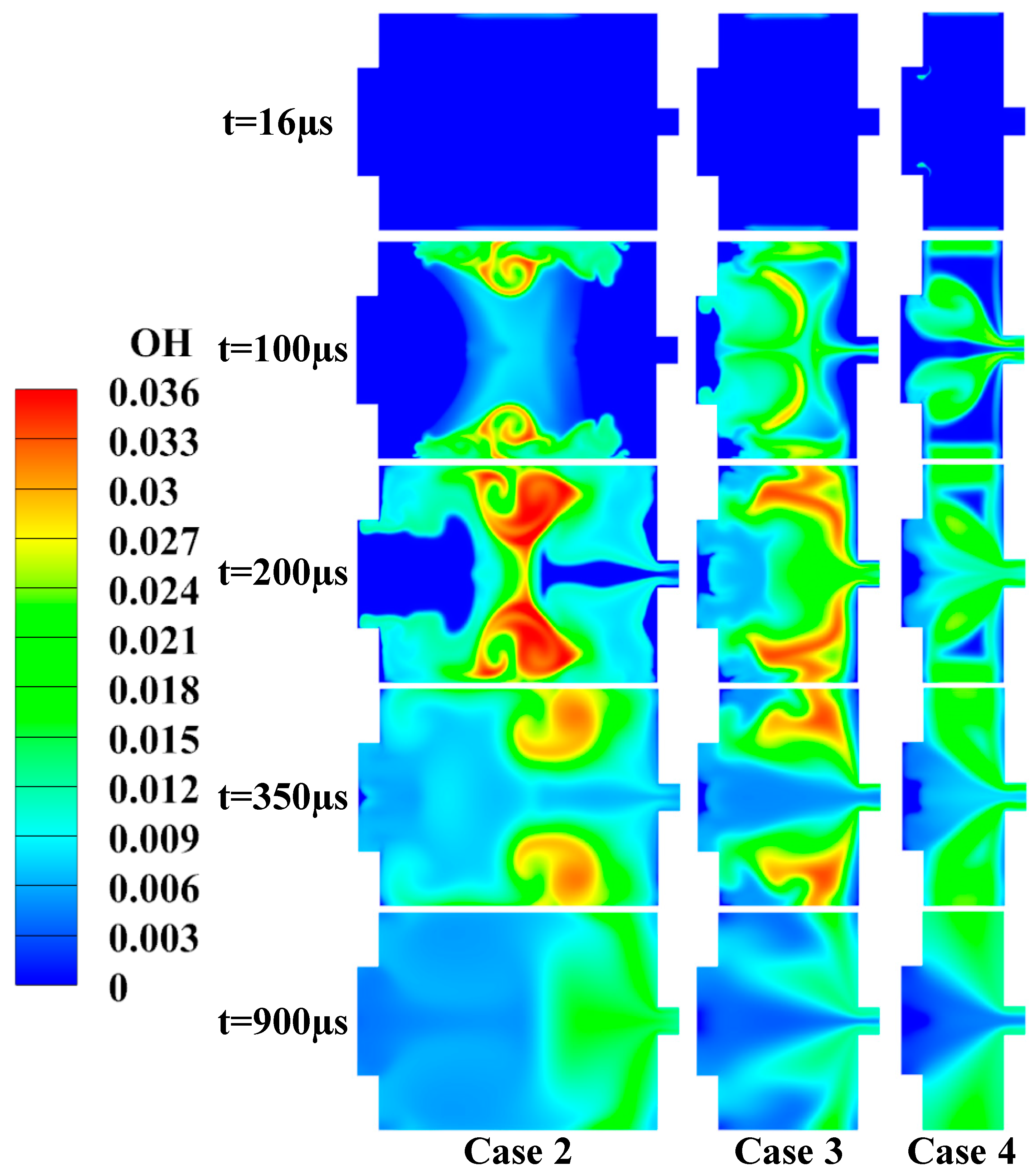


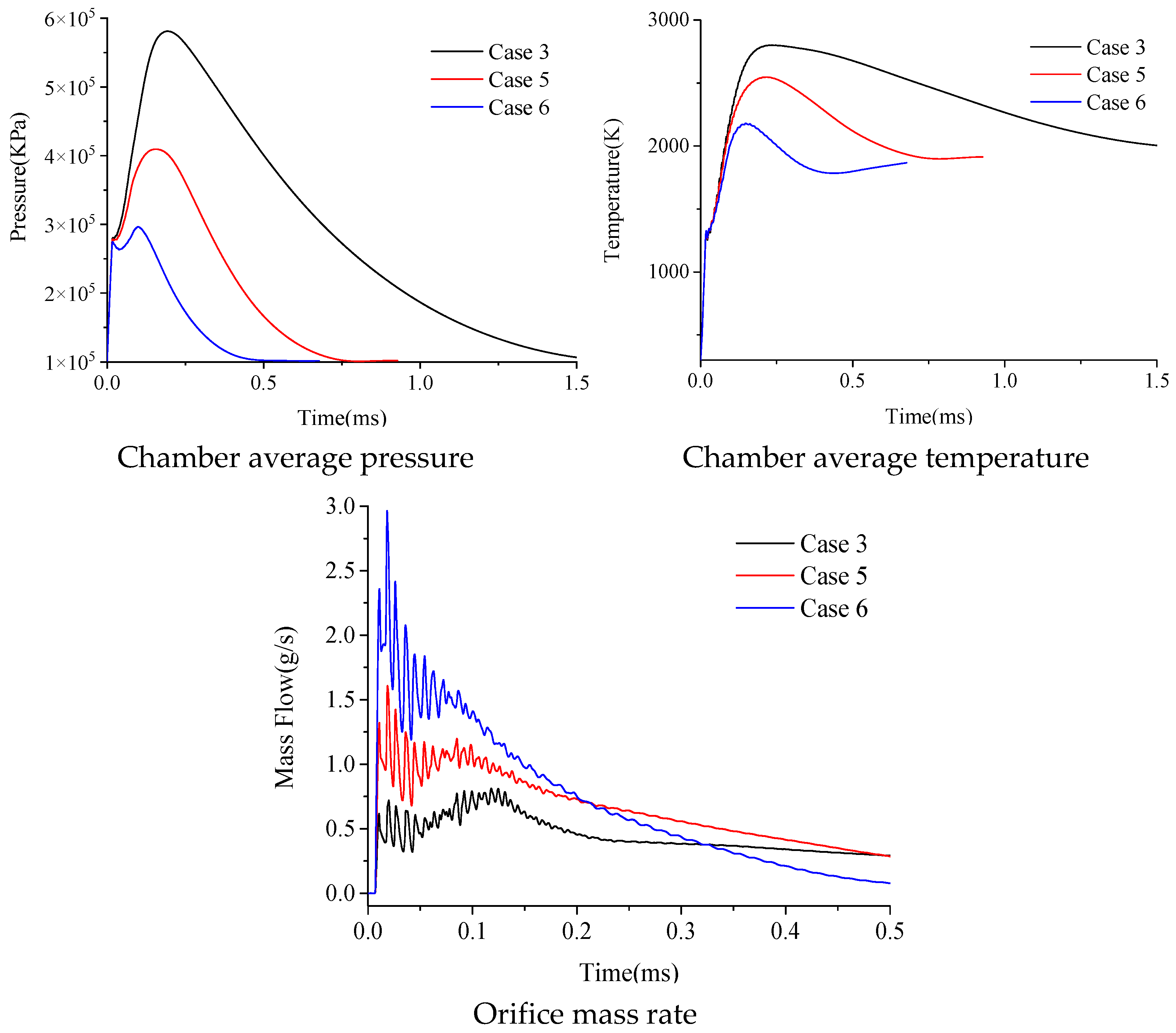
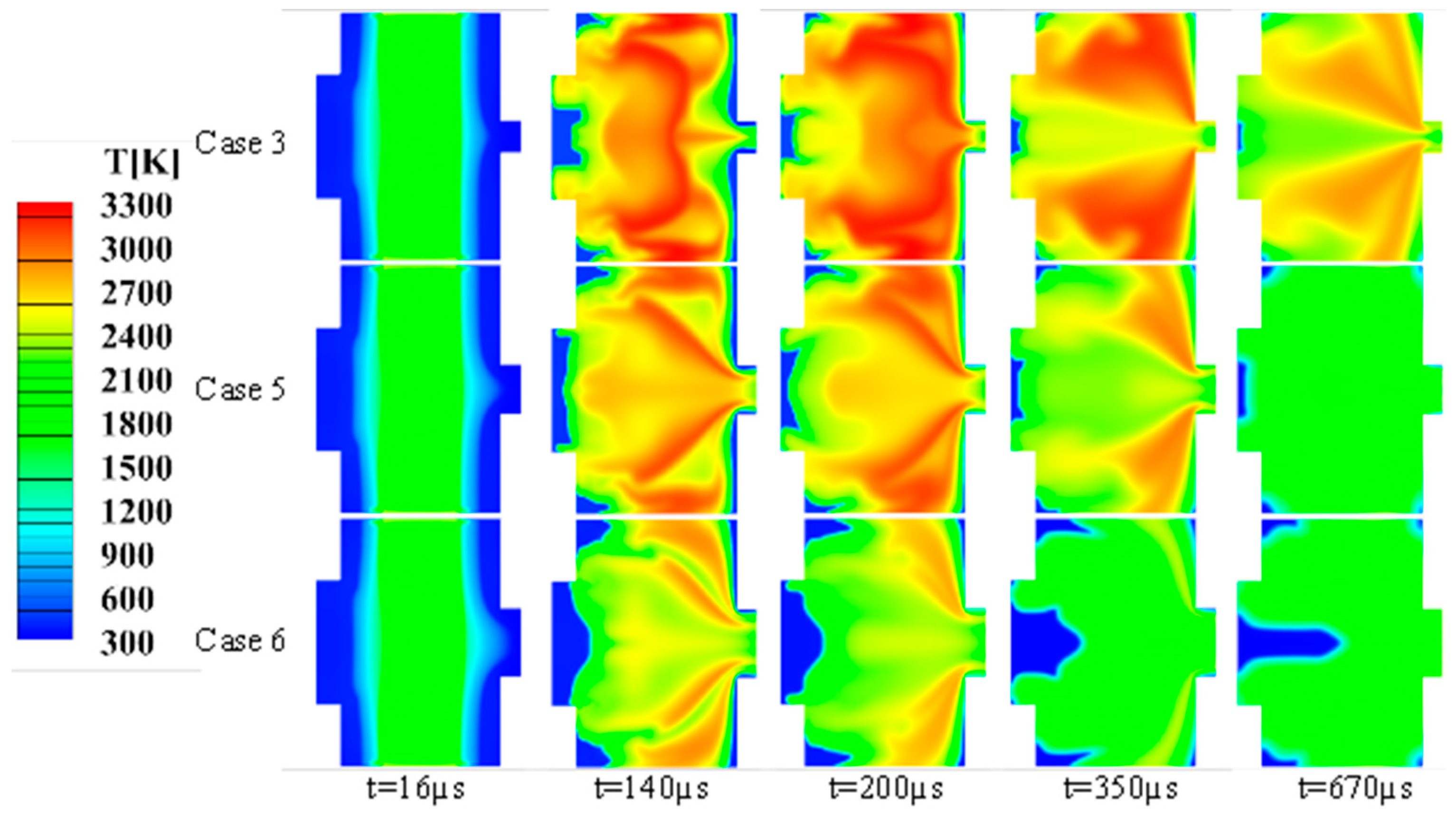
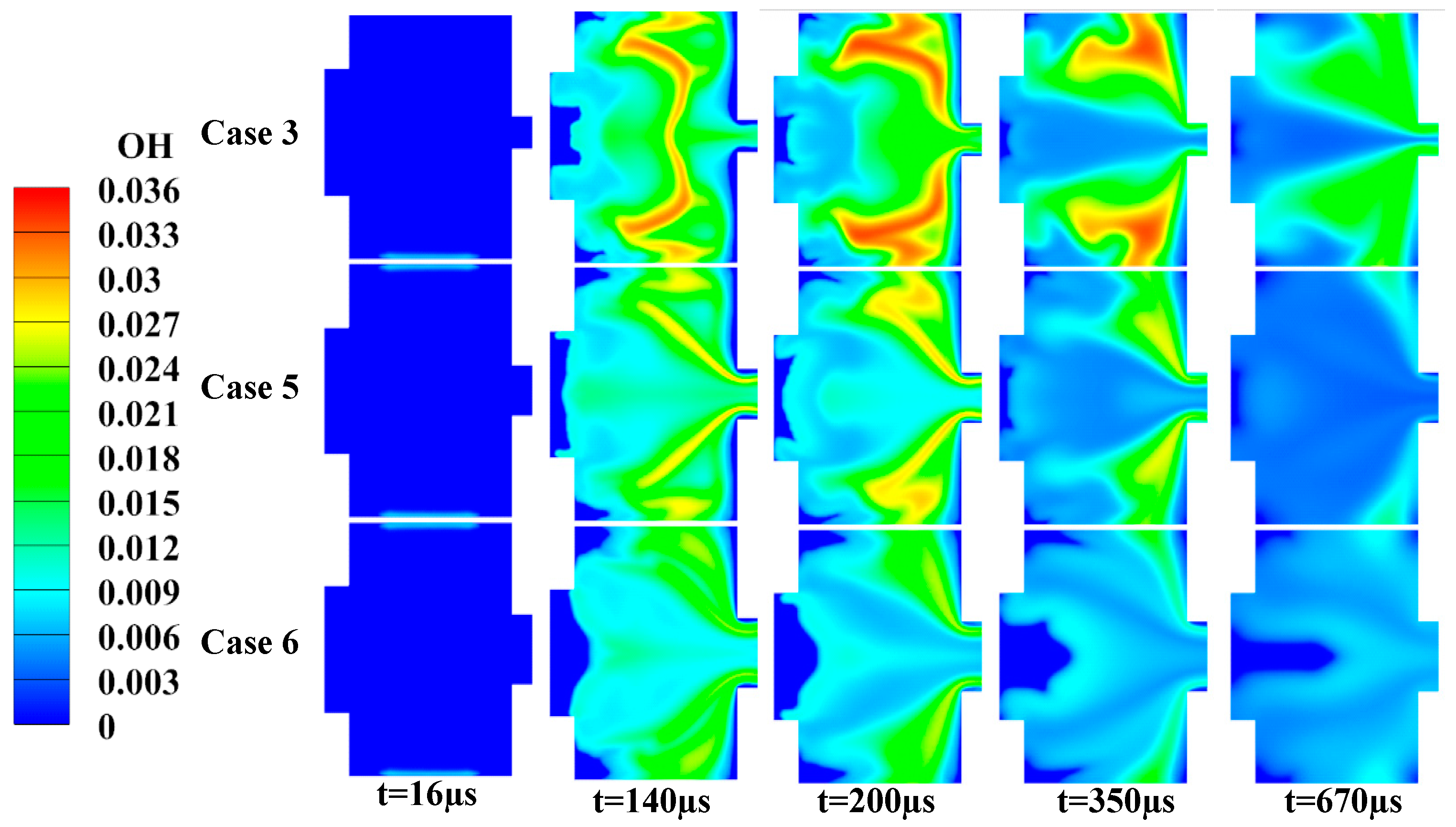
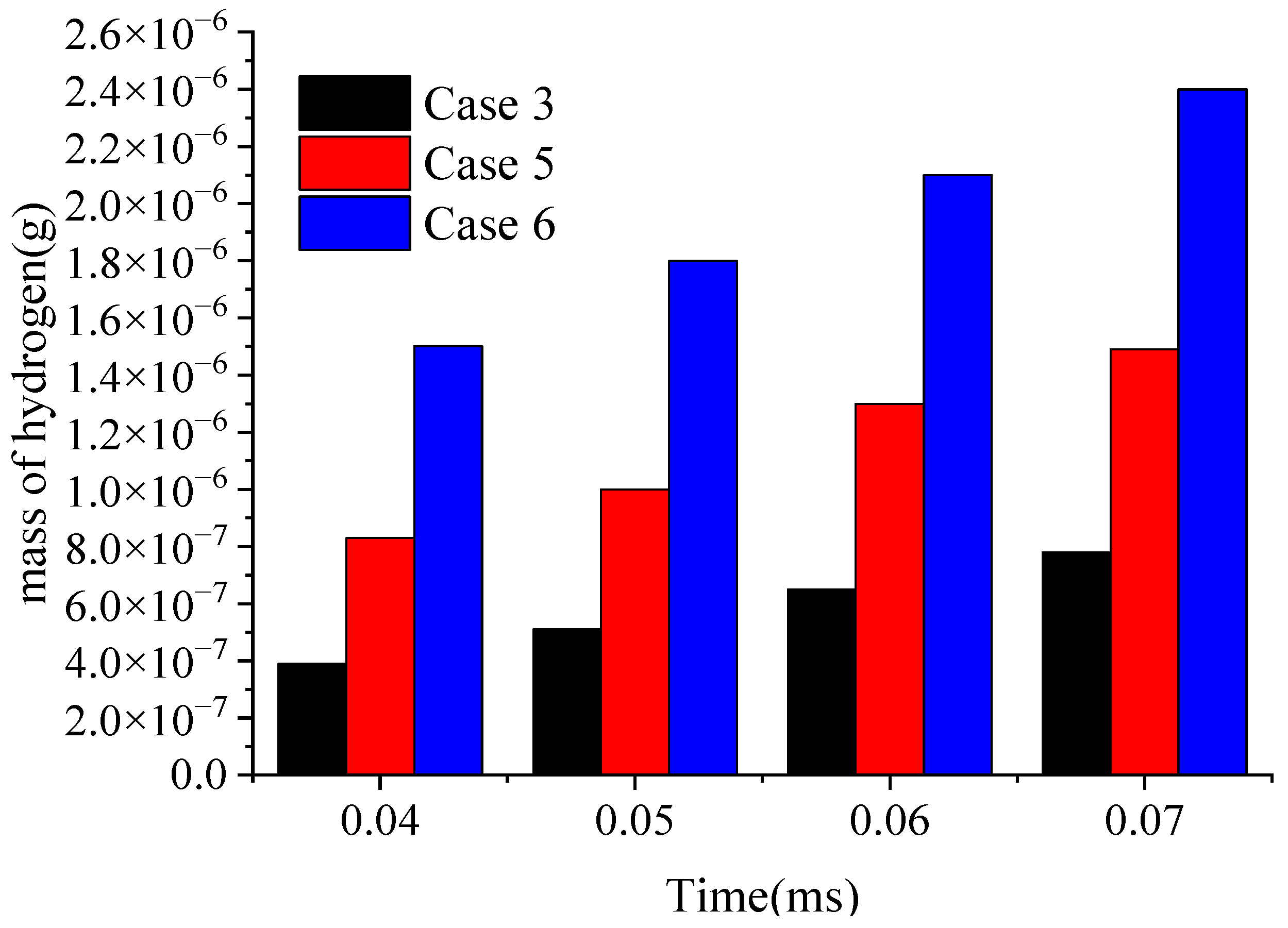
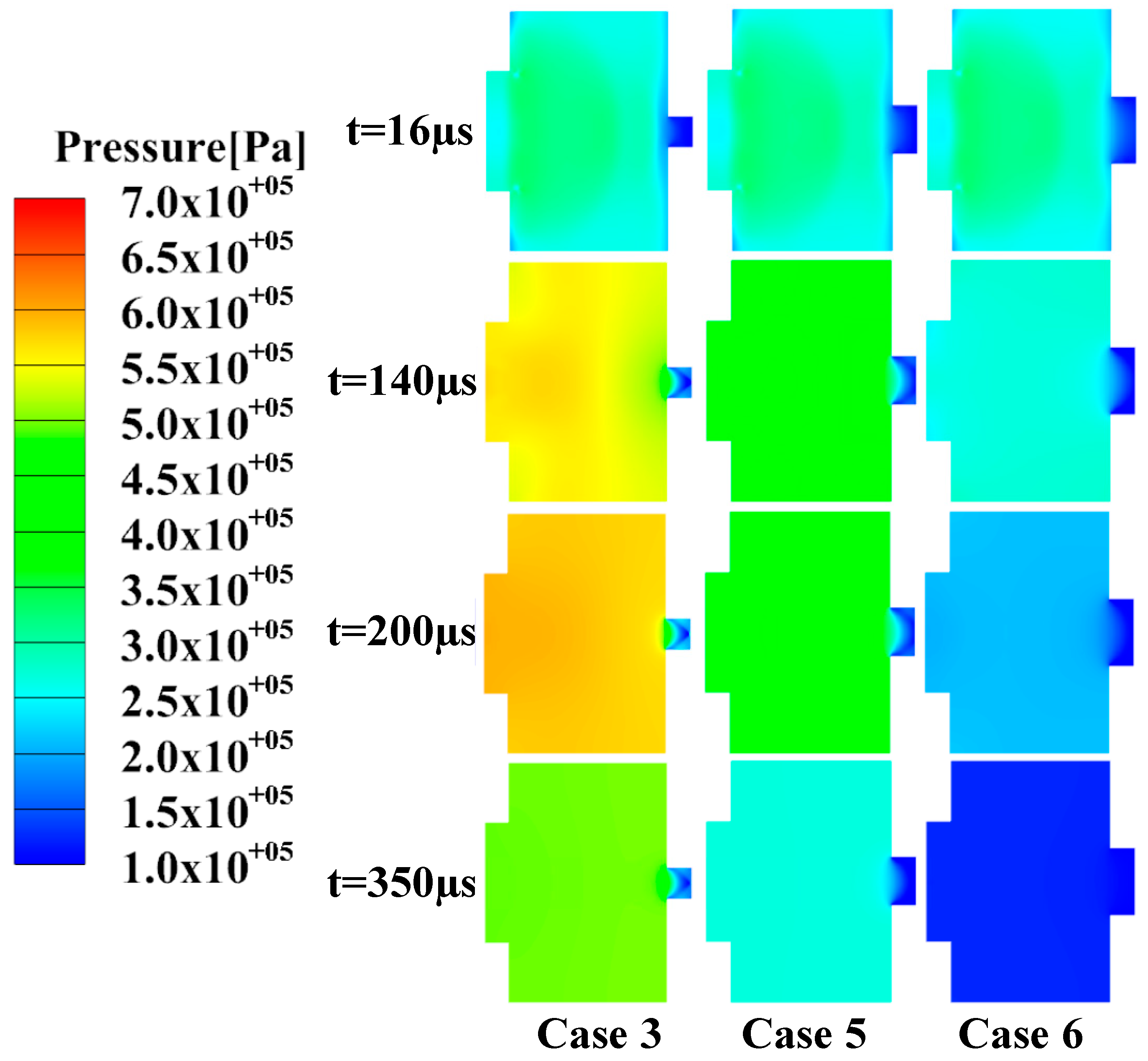
| Experimental Results | Numerical Results | |
|---|---|---|
| Temperature (K) | 2382 | 2392 |
| Mass fraction of H2O | 0.323 | 0.317 |
| Mass fraction of O2 | 0.005 | 0.007 |
| Mass fraction of H2 | 0.015 | 0.018 |
| Mass fraction of OH | 0.007 | 0.009 |
| Mass fraction of H | 0.002 | 0.003 |
| Mass fraction of O | 0.001 | 0.0012 |
| Mass fraction of NO | 0.003 | - |
| Mass fraction of N2 | 0.644 | 0.63 |
| Cases | 1 | 2 | 3 | 4 | 5 | 6 |
|---|---|---|---|---|---|---|
| Orifice Diameter | 1.3 mm | 1.3 mm | 1.3 mm | 1.3 mm | 2 mm | 2.8 mm |
| Chamber length | 6.5 mm | 13 mm | 6.5 mm | 3.75 mm | 6.5 mm | 6.5 mm |
Disclaimer/Publisher’s Note: The statements, opinions and data contained in all publications are solely those of the individual author(s) and contributor(s) and not of MDPI and/or the editor(s). MDPI and/or the editor(s) disclaim responsibility for any injury to people or property resulting from any ideas, methods, instructions or products referred to in the content. |
© 2023 by the authors. Licensee MDPI, Basel, Switzerland. This article is an open access article distributed under the terms and conditions of the Creative Commons Attribution (CC BY) license (https://creativecommons.org/licenses/by/4.0/).
Share and Cite
Chen, H.; Zhou, Y.; Luo, Z.; Cheng, P. Numerical Investigation of Effect of Structural Parameters on the Performance of a Combustion-Driven Sparkjet Actuator. Actuators 2023, 12, 250. https://doi.org/10.3390/act12060250
Chen H, Zhou Y, Luo Z, Cheng P. Numerical Investigation of Effect of Structural Parameters on the Performance of a Combustion-Driven Sparkjet Actuator. Actuators. 2023; 12(6):250. https://doi.org/10.3390/act12060250
Chicago/Turabian StyleChen, Hai, Yan Zhou, Zhenbing Luo, and Pan Cheng. 2023. "Numerical Investigation of Effect of Structural Parameters on the Performance of a Combustion-Driven Sparkjet Actuator" Actuators 12, no. 6: 250. https://doi.org/10.3390/act12060250






